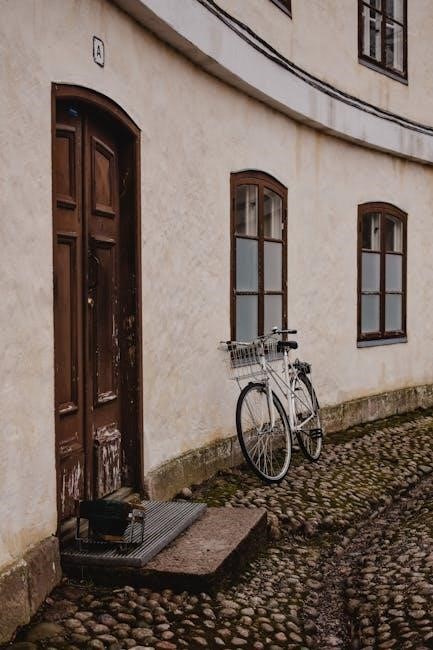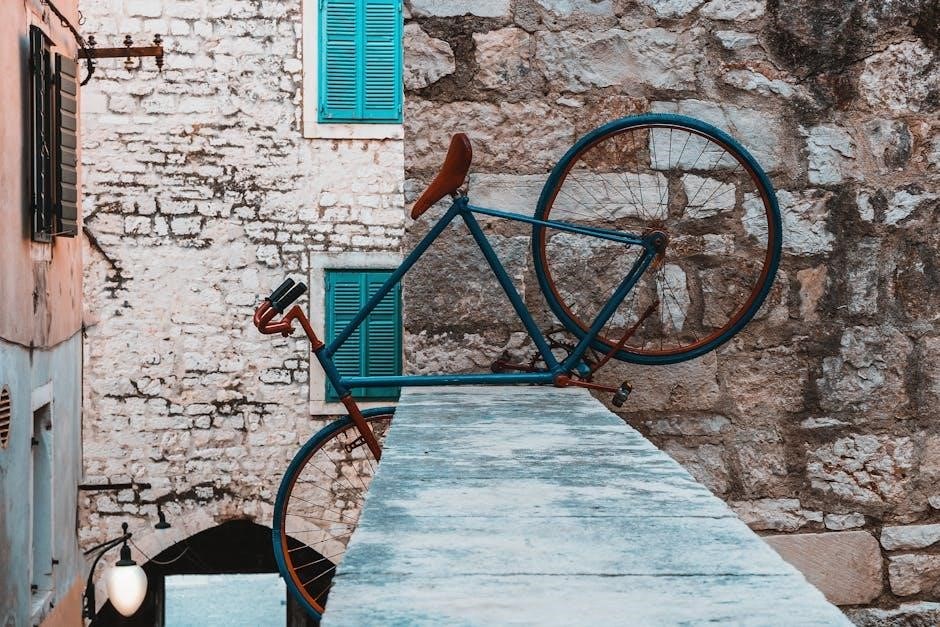The resurgence of interest in vintage bicycles has sparked a vibrant market, with enthusiasts and collectors seeking rare, well-preserved bikes. This guide explores their value, history, and investment potential, offering insights for buyers, sellers, and restorers alike.
Understanding the Growing Popularity of Vintage Bicycles
The resurgence of vintage bicycles stems from a blend of nostalgia, sustainability, and the allure of unique, handcrafted designs. Collectors and enthusiasts appreciate the historical significance, while everyday riders value their durability and timeless aesthetics. The market has grown as people seek eco-friendly alternatives and a connection to the past, driving demand for these classic bikes.
Why Vintage Bicycles Hold Value
Vintage bicycles maintain their value due to their exceptional craftsmanship, nostalgic appeal, and sustainability. Many were built with high-quality materials and attention to detail, making them durable and timeless. Their unique designs and historical significance attract collectors and enthusiasts, while the current trend toward eco-friendly transportation further elevates their desirability. As people seek durable, character-rich alternatives to modern bikes, vintage bicycles become prized possessions that combine functionality with a connection to the past.
Factors Affecting the Value of Vintage Bicycles
Rarity, condition, brand reputation, and original components significantly influence the value of vintage bicycles. These factors, along with market demand, determine their worth in the collector’s market.

Rarity and Demand in the Market
Rarity and market demand are crucial in determining the value of vintage bicycles. Limited production models or those with unique features often attract higher prices due to their exclusivity. Additionally, cultural trends and nostalgia play a role in driving demand, as collectors seek bikes that evoke historical or sentimental value. Understanding these dynamics helps enthusiasts and investors make informed decisions in the competitive vintage bicycle market.
Condition and Preservation Quality
The condition and preservation quality of a vintage bicycle significantly impact its value. Bikes that retain their original components and show minimal wear are highly sought after. A well-maintained frame, intact decals, and functional parts contribute to a higher appraisal. Conversely, bikes requiring extensive restoration may sell for less, though they offer potential for enthusiasts willing to invest time and effort into bringing them back to their former glory.
Brand Reputation and Historical Significance
Brand reputation and historical significance play a crucial role in determining the value of vintage bicycles. Renowned manufacturers like Schwinn, Peugeot, and Raleigh often command higher prices due to their legacy and craftsmanship. Bikes linked to historical events or iconic designs, such as the 1960s era racing bikes, are particularly prized by collectors. The prestige of the brand and its place in cycling history can elevate a bicycle’s worth, making it a treasured possession for enthusiasts and investors.
Original Components and Modifications
The presence of original components significantly impacts a vintage bicycle’s value. Bikes retaining their authentic parts, such as derailleurs, brakes, and wheels, are highly sought after by purists. Modifications, like modern upgrades, can detract from value unless they are period-correct or enhance functionality without altering the bike’s character. Buyers often prefer unrestored bicycles with original finishes, as they reflect the bike’s true heritage and authenticity, making them more desirable in the vintage market.

How to Determine the Value of Your Vintage Bicycle
Determining the value of a vintage bicycle involves assessing its condition, rarity, and historical significance. Researching similar models, consulting experts, and reviewing market trends provide accurate appraisals.
Researching Market Trends and Auctions
Researching market trends and auctions is crucial for understanding the value of vintage bicycles. By analyzing past sales of similar models, enthusiasts can identify pricing patterns and demand. Online platforms, auction houses, and collector forums provide valuable insights. Additionally, attending vintage cycling events and joining communities can offer direct access to experts and firsthand information. Staying informed about current trends ensures that buyers and sellers make well-informed decisions in the competitive vintage bicycle market.
Importance of Professional Appraisals
Professional appraisals are essential for accurately determining the value of vintage bicycles. Experts assess factors like rarity, condition, and historical significance to provide a credible evaluation. Their reports often include detailed descriptions of components and any unique features. This not only helps in setting fair market prices but also ensures transparency for buyers and sellers; Additionally, appraisals can be crucial for insurance purposes or estate planning, offering a trusted reference point in the vintage bicycle market.

The Role of Restoration in Vintage Bicycle Value
Restoration can significantly enhance or diminish a vintage bicycle’s value, depending on its execution. Preserving originality while addressing wear is crucial for maintaining authenticity and appeal.
When to Restore vs. Preserve
Deciding whether to restore or preserve a vintage bicycle hinges on its condition and historical significance. If the bike retains most of its original components and shows minimal wear, preservation is often the best approach to maintain authenticity. However, if the bicycle has significant damage or is missing key parts, restoration may be necessary to return it to a functional or display-worthy state while aiming to keep alterations minimal and period-correct.
Costs and Benefits of Restoration
Restoring a vintage bicycle can enhance its value but comes with significant costs. Parts sourcing, labor, and materials add up quickly. However, a well-executed restoration can elevate the bike’s market price, especially if it retains originality. The emotional satisfaction of reviving a classic bike often outweighs financial considerations for enthusiasts. Balancing cost and quality is key to ensuring the restoration adds value without overshooting potential returns in the vintage bicycle market.
A Buyer’s Guide to Purchasing Vintage Bicycles
When buying a vintage bike, assess condition, rarity, and original components. Research market trends and seek professional appraisals to ensure a fair purchase, avoiding costly surprises and enhancing satisfaction.
What to Look for When Inspecting a Vintage Bike
Inspecting a vintage bike requires attention to detail. Check the frame for rust or dents, ensure all components are original, and test the brakes and gears for functionality. Tires should be in good condition, and the chain should be clean and well-lubricated. Look for any signs of wear or modifications that could affect value. A thorough inspection helps determine authenticity and ensures a worthwhile purchase or restoration project.
A Seller’s Guide to Getting the Best Price
Maximize your vintage bike’s value by showcasing its rarity, condition, and originality. Use high-quality photos and detailed descriptions when listing online, and consider professional appraisals to attract serious buyers.
How to Market and Present Your Vintage Bicycle
To attract potential buyers, showcase your vintage bicycle with high-quality photos from multiple angles. Highlight its unique features, such as original components or rare designs. Include detailed descriptions of its condition, history, and any restoration work. Use proper lighting to accentuate the bike’s aesthetic appeal. Consider creating a compelling story about its past to add emotional value. Display it in a clean, well-organized environment to make it stand out. This approach will help buyers appreciate its worth and connect with its heritage.

Tips for Maintaining and Storing Vintage Bicycles
Store your vintage bicycle in a dry, climate-controlled environment to prevent rust. Regularly clean and lubricate moving parts to maintain functionality and preserve its original charm effectively.
Best Practices for Long-Term Preservation
For long-term preservation, store your vintage bicycle in a dry, climate-controlled environment to prevent rust and damage. Regularly clean the frame and components with mild soap and water, avoiding harsh chemicals. Lubricate moving parts to maintain functionality and prevent corrosion. Inspect tires and wheels for wear, and consider storing the bike upright or on a wall mount to save space. Avoid direct sunlight to preserve paint and decals, ensuring your vintage bike remains in optimal condition for years to come.
The Investment Potential of Vintage Bicycles
Vintage bicycles can be a rewarding investment due to their rarity, historical significance, and growing demand. Well-maintained bikes with original components often appreciate in value, offering a unique blend of nostalgia and functionality for collectors and enthusiasts alike.
Are Vintage Bicycles a Worthwhile Investment?
Vintage bicycles can indeed be a worthwhile investment, especially for those who appreciate their historical charm and craftsmanship. With proper care and maintenance, these bikes can appreciate in value over time. Rare models and those in excellent condition are particularly sought after. Additionally, the emotional and cultural significance of vintage bicycles adds to their appeal, making them not only a financial investment but also a cherished possession for many enthusiasts.

Where to Find Vintage Bicycles
Vintage bicycles can be discovered at antique shops, estate sales, online marketplaces, and specialty bike auctions. These sources offer a variety of rare and unique finds.
Top Sources for Acquiring Vintage Bikes
Vintage bicycles can be sourced from various avenues, including online marketplaces like eBay and Etsy, local bike shops, and antique stores. Estate sales, flea markets, and community forums often yield hidden gems. Additionally, specialized auctions and collector groups provide opportunities to find rare models. Social media platforms like Facebook Marketplace and Instagram are also popular for discovering vintage bikes. Persistence and patience are key to uncovering unique and valuable bicycles.
The vintage bicycle market offers a rewarding blend of history, craftsmanship, and investment potential. Enthusiasts and collectors alike can find joy in restoring, riding, and preserving these timeless machines.
Final Thoughts on the Vintage Bicycle Market
The vintage bicycle market continues to captivate enthusiasts, blending nostalgia with investment potential. As demand grows, rare and well-maintained bikes appreciate in value, making them prized possessions. Whether for riding, collecting, or restoring, vintage bicycles offer a unique connection to cycling history. The market’s future looks promising, driven by passionate communities and the timeless allure of classic designs. For those considering entry, research, patience, and a keen eye for quality are essential to navigating this rewarding hobby and investment opportunity.


